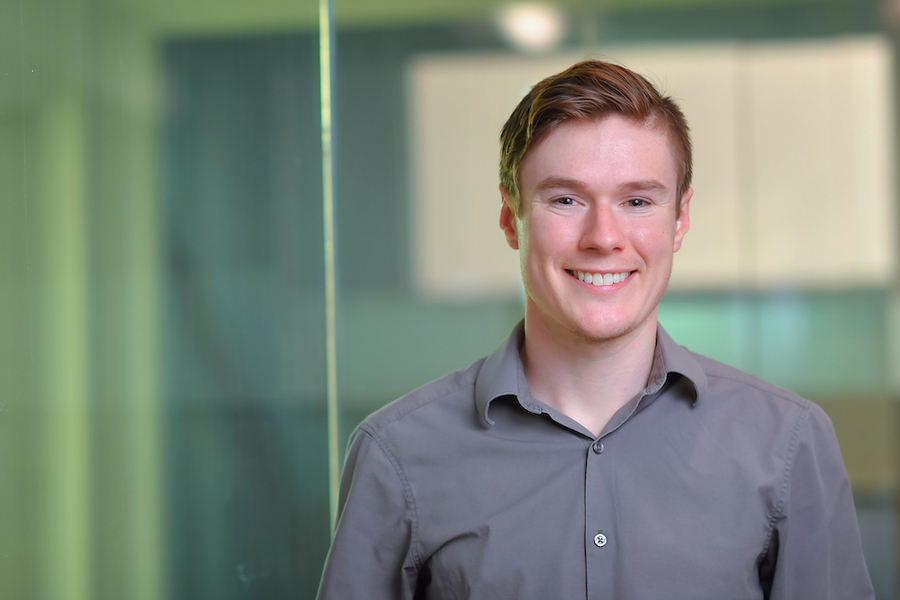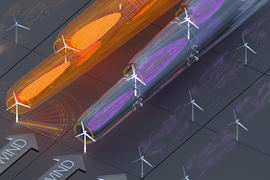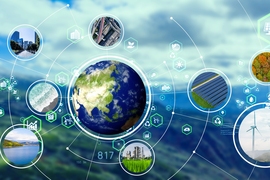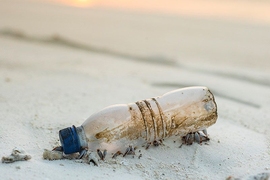Michael Howland was in his office at MIT, watching real-time data from a wind farm 7,000 miles away in northwest India, when he noticed something odd: Some of the turbines weren’t producing the expected amount of electricity.
Howland, the Esther and Harold E. Edgerton Assistant Professor of Civil and Environmental Engineering, studies the physics of the Earth’s atmosphere and how that information can optimize renewable energy systems. To accomplish this, he and his team develop and use predictive models, supercomputer simulations, and real-life data from wind farms, such as the one in India.
The global wind power market is one of the most cost-competitive and resilient power sources across the world, the Global Wind Energy Council reported last year. The year 2020 saw record growth in wind power capacity, thanks to a surge of installations in China and the United States. Yet wind power needs to grow three times faster in the coming decade to address the worst impacts of climate change and achieve federal and state climate goals, the report says.
“Optimal wind farm design and the resulting cost of energy are dependent on the wind,” Howland says. “But wind farms are often sited and designed based on short-term historical climate records.”
In October 2021, Howland received a Seed Fund grant from the MIT Energy Initiative (MITEI) to account for how climate change might affect the wind of the future. “Our initial results suggest that considering the uncertainty in the winds in the design and operation of wind farms can lead to more reliable energy production,” he says.
Most recently, Howland and his team came up with a model that predicts the power produced by each individual turbine based on the physics of the wind farm as a whole. The model can inform decisions that may boost a farm’s overall output.
The state of the planet
Growing up in a suburb of Philadelphia, the son of neuroscientists, Howland’s childhood wasn’t especially outdoorsy. Later, he’d become an avid hiker with a deep appreciation for nature, but a ninth-grade class assignment made him think about the state of the planet, perhaps for the first time.
A history teacher had asked the class to write a report on climate change. “I remember arguing with my high school classmates about whether humans were the leading cause of climate change, but the teacher didn’t want to get into that debate,” Howland recalls. “He said climate change was happening, whether or not you accept that it’s anthropogenic, and he wanted us to think about the impacts of global warming, and solutions. I was one of his vigorous defenders.”
As part of a research internship after his first year of college, Howland visited a wind farm in Iowa, where wind produces more than half of the state’s electricity. “The turbines look tall from the highway, but when you’re underneath them, you’re really struck by their scale,” he says. “That’s where you get a sense of how colossal they really are.” (Not a fan of heights, Howland opted not to climb the turbine’s internal ladder to snap a photo from the top.)
After receiving an undergraduate degree from Johns Hopkins University and master’s and PhD degrees in mechanical engineering from Stanford University, he joined MIT’s Department of Civil and Environmental Engineering to focus on the intersection of fluid mechanics, weather, climate, and energy modeling. His goal is to enhance renewable energy systems.
An added bonus to being at MIT is the opportunity to inspire the next generation, much like his ninth-grade history teacher did for him. Howland’s graduate-level introduction to the atmospheric boundary layer is geared primarily to engineers and physicists, but as he sees it, climate change is such a multidisciplinary and complex challenge that “every skill set that exists in human society can be relevant to mitigating it.”
“There are the physics and engineering questions that our lab primarily works on, but there are also questions related to social sciences, public acceptance, policymaking, and implementation,” he says. “Careers in renewable energy are rapidly growing. There are far more job openings than we can hire for right now. In many areas, we don’t yet have enough people to address the challenges in renewable energy and climate change mitigation that need to be solved.
“I encourage my students — really, everyone I interact with — to find a way to impact the climate change problem,” he says.
Unusual conditions
In fall 2021, Howland was trying to explain the odd data coming in from India.
Based on sensor feedback, wind turbines’ software-driven control systems constantly tweak the speed and the angle of the blades, and what’s known as yaw — the orientation of the giant blades in relation to the wind direction.
Existing utility-scale turbines are controlled “greedily,” which means that every turbine in the farm automatically turns into the wind to maximize its own power production.
Though the turbines in the front row of the Indian wind farm were reacting appropriately to the wind direction, their power output was all over the place. “Not what we would expect based on the existing models,” Howland says.
These massive turbine towers stood at 100 meters, about the length of a football field, with blades the length of an Olympic swimming pool. At their highest point, the blade tips lunged almost 200 meters into the sky.
Then there’s the speed of the blades themselves: The tips move many times faster than the wind, around 80 to 100 meters per second — up to a quarter or a third of the speed of sound.
Using a state-of-the-art sensor that measures the speed of incoming wind before it interacts with the massive rotors, Howland’s team saw an unexpectedly complex airflow effect. He covers the phenomenon in his class. The data coming in from India, he says, displayed “quite remarkable wind conditions stemming from the effects of Earth’s rotation and the physics of buoyancy that you don’t always see.”
Traditionally, wind turbines operate in the lowest 10 percent of the atmospheric boundary layer — the so-called surface layer — which is affected primarily by ground conditions. The Indian turbines, Howland realized, were operating in regions of the atmosphere that turbines haven’t historically accessed.
Trending taller
Howland knew that airflow interactions can persist for kilometers. The interaction of high winds with the front-row turbines was generating wakes in the air similar to the way boats generate wakes in the water.
To address this, Howland’s model trades off the efficiency of upwind turbines to benefit downwind ones. By misaligning some of the upwind turbines in certain conditions, the downwind units experience less wake turbulence, increasing the overall energy output of the wind farm by as much as 1 percent to 3 percent, without requiring additional costs. If a 1.2 percent energy increase was applied to the world’s existing wind farms, it would be the equivalent of adding more than 3,600 new wind turbines — enough to power about 3 million homes.
Even a modest boost could mean fewer turbines generating the same output, or the ability to place more units into a smaller space, because negative interactions between the turbines can be diminished.
Howland says the model can predict potential benefits in a variety of scenarios at different types of wind farms. “The part that’s important and exciting is that it’s not just particular to this wind farm. We can apply the collective control method across the wind farm fleet,” he says, which is growing taller and wider.
By 2035, the average hub height for offshore turbines in the United States is projected to grow from 100 meters to around 150 meters — the height of the Washington Monument.
“As we continue to build larger wind turbines and larger wind farms, we need to revisit the existing practice for their design and control,” Howland says. “We can use our predictive models to ensure that we build and operate the most efficient renewable generators possible.”
Looking to the future
Howland and other climate watchers have reason for optimism with the passage in August 2022 of the Inflation Reduction Act, which calls for a significant investment in domestic energy production and for reducing carbon emissions by roughly 40 percent by 2030.
But Howland says the act itself isn’t sufficient. “We need to continue pushing the envelope in research and development as well as deployment,” he says. The model he created with his team can help, especially for offshore wind farms experiencing low wind turbulence and larger wake interactions.
Offshore wind can face challenges of public acceptance. Howland believes that researchers, policymakers, and the energy industry need to do more to get the public on board by addressing concerns through open public dialogue, outreach, and education.
Howland once wrote and illustrated a children’s book, inspired by Dr. Seuss’s “The Lorax,” that focused on renewable energy. Howland recalls his “really terrible illustrations,” but he believes he was onto something. “I was having some fun helping people interact with alternative energy in a more natural way at an earlier age,” he says, “and recognize that these are not nefarious technologies, but remarkable feats of human ingenuity.”









